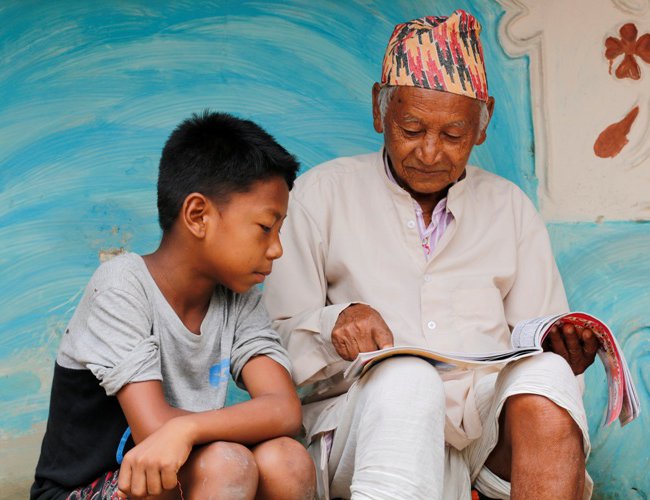
Literacy refers to the ability to read and write. UNESCO defines literacy as the "ability to identify, understand, interpret, create, communicate, compute and use printed and written materials associated with varying contexts. It is a learning continuum enabling individuals to achieve their goals, develop their knowledge and potential, and participate fully in their community and wider society.The Government of Nepal is keen on improving the literacy rate, with initiatives like the National Literacy Campaign launched from 2008-2012, ‘Literate Nepal Mission’ on achieving literacy for all between 2012 and 2015, allocating around 3% of its total education budget to non-formal education and literacy. Technical and financial support from development partners has also greatly contributed to addressing the challenges. As a result, Nepal’s literacy rate has improved from 2% (before 1951) to around 67%, according to the UNESCO 2022 report (Sources for article\Report on Adult Literacy Campaign_UNESCO.pdf).
Despite this overall progress, females still lag behind – only three in five females are literate, compared to four in five males. Inequity is another issue as another survey found that Muslims, Dalits in the Terairegion, and other caste groups residing in Madhesh Province, particularly in rural areas with poor economic backgrounds, had even lower literacy rate which is around 11% whereas the literacy rate of Madhesh province is around 50%; much lower than the national average (Sources for article\Nepal-UPR-2015-Dalit-Coalition-and-IDSN-report.pdf). While the world marked International Youth day in August, youth in Nepal face a broad range of inequalities and barrierssuch as gender, caste, socioeconomic, cultural, physical abilities, and geography; and limited opportunities to reduce these inequalities.For example, although there are scholarships available, they often don’t reach the intended beneficiary, and if they do, these are often insufficient to meet the indirect cost of schooling for the poorest families. A dismal 0.3% of learners with disability are enrolled in school compared to close to two percent of Nepal’s population that has a disability. Low school enrolment and attendance can be attributed tothe lack of disabled-friendly infrastructure in many schools including accessible toilets,and inadequate initiatives to bring children back to school, particularly street children, child labourers,and married adolescents. Moreover, around one-third of the community schools do not have a provision for separate toilets for girls and boys, aminimum requirement set by the government under Prioritized Minimum Enabling Condition (PMEC). Likewise, there are 47.2% female teachers at the basic level but only 20.4% of teachers atthe secondary level are females (Sources for article\ASIP AWPB 2022.023 MoEST.docx) – yet past lessons show that increasing the number of female teachers is one way to get more girls into school, and to keep them there.This is especially true in a country like Nepalwhere cultural barriers make it difficult for girls to attend school.
The Social Welfare Council (SWC)’sdata show that there are more than 200 International NGOs working with the government of Nepal to support the achievementof national education goalsand priorities(Sources for article\List of INGOs in Nepal_SWC.pdf). These Civil Society Organisations are well aware that there is a strong and positive relationship between the literacy of parents, parental involvement and learning of children as evidenced by their broad range of interventions focused on formal and informal education (adult literacy). For example, several studies have noted that parents’ involvement in early literacy is directly linked to academic achievement and that children of literate parents are likely to go to school, stay in school and enjoy learning.There are many ways that parents practice positive parenting. To maximize the benefits, they are required to be literate and sensitized to guide their children during studies, play with children, support children to socialize in the community and involvement in school activities. Studies shows that female literacy and education reduces infant mortality and enhances child development and learning. Therefore, we should have the priority to increase the female literacy as well as literacy of marginalized groups.
World Vision International Nepal has tailored this into the Inclusive Playful Parenting and Reading Awareness Workshops that directly equip parents with literacy and positive parenting skills and practices. These are based on nurturing care framework, combining health and nutrition, early stimulation, early education, social-emotional care, and responsive caregiving. It helps in improving the ecosystem for playful, nurturing, and holistic learning and development for the children. The reading awareness workshop improves parents’ literacy and sensitizes them on how to support their children’s education and learning at home as well asschool. A notable impact is that parents and children who participated in the inclusive playful parenting and reading awareness sessions from 2015 to 2017 were found to be 1.5 times better in reading comprehension (retrieved from https://www.worldvision.org/education-news-stories/literacy-rates-improving-nepal).Higher literacy levels are important in changing people’s mindsets, attitudestowardlife along witheligibility and fitness for a job and/ or job creation. This in turn helps them earn an income and generate wealth (Dollpohr.org, 2015). Increased literacy remains one area that will elevate and contribute to sustainable development in Nepal. There lies a need for all stakeholders in the education sector to continue investments to address not just the gender barriers but also overcome the socio-economic gap as well.
Nepal has already declared more than 50 districts as total literate districts. Some intensive initiatives are being conducted in the remaining to declare total literate districts. In the ongoing programme approach and as post literacy initiatives continuation of already initiatives as mobilization of students from grade 9-10 is required but that should be liked with the internal assessment system of the students (project work) and for longer period of time. The diverse needs of the adults mainly the women should be addressed which also promotes culture of literacy in the community. The ‘literacy-first approach’ in adult literacy initiatives that promotes functional literacy should be linked with other sectors such as financial literacy, maternal and child health, immunization, saving habits, social beliefs, social protection. Social behavours tactics such as Short Message Services (SMS), Interactive Voice Response (IVR), Home posters, behavior journalism can be used that encourages to literate the people. The lives of people, context, learning opportunities are being changed due to the emergence and use of technologies. The learning opportunities are being expanded those can be tapped in and appropriately utilized so that the literacy and post-literacy initiatives will be more meaningful and sustainable to achieve to achieve the goal of ‘Literate Nepal Mission’ of government of Nepal.
Deepak Dulal is the Sectoral Portfolio Advisor-Education at World Vision International Nepal. The article has been published on the occasion of International Literacy Day 2022.

















